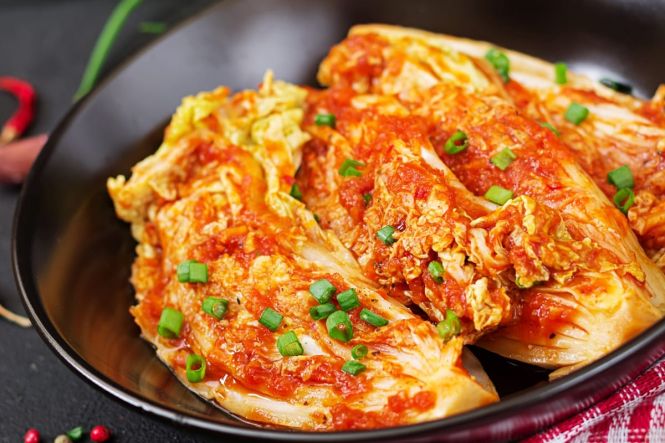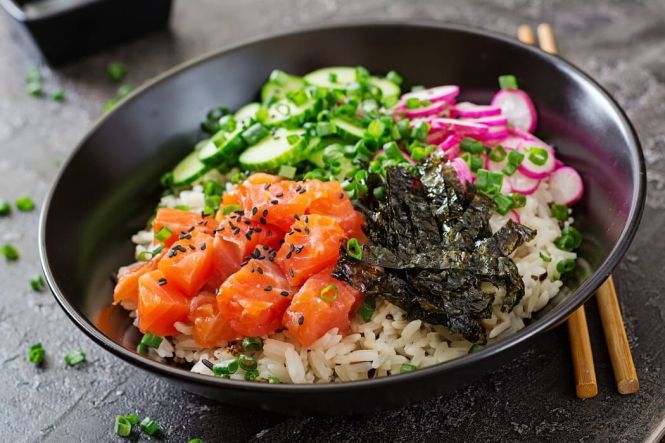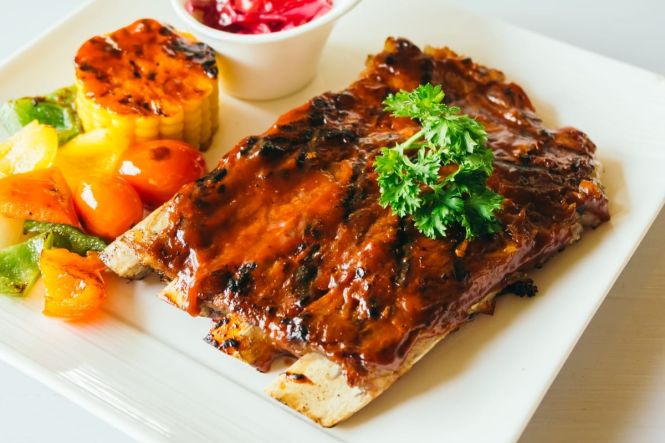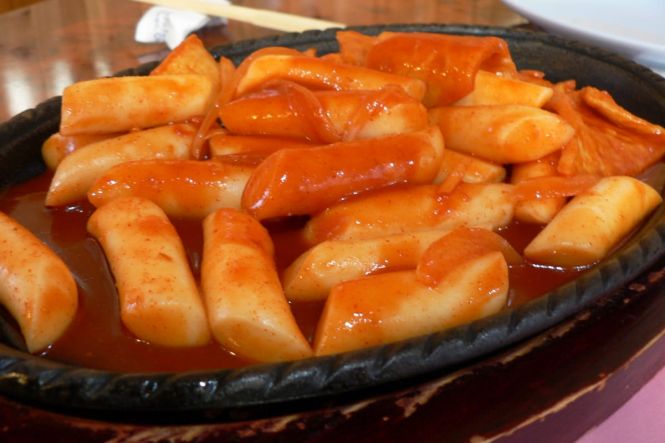


If there is a land that manages to successfully bring together ancient traditions and cutting-edge technology, it is South Korea. You could argue that pretty much every country of the East does that today: Japan, China, Indonesia, Malaysia, etc. True, but Koreans have created the most vivid combinations. How about a house in an old architectural style that’s 3D-printed? South Korea does that. Moreover, the materials used for the purpose are not some plastic filament, but actual wood, stone, and granite, all transformed to be usable with the latest construction tech. And this is just one example.
Do South Koreans practice a similar approach to their cuisine, a set of culinary customs and traditions as ancient as their state? They do! But in this piece, we shall explore Korean foods that made it through time and survived to this very day largely unchanged. If you are looking for something more outlandish, check out another piece dedicated to Seoul on Restaurant Guru, Visionary Michelin-starred dining in Seoul, South Korea. And here, we’ll start with healthy foods, move through the famous Korean BBQ, and wrap it up with some authentic street food. Let’s go!

Kimchi is a traditional Korean dish made with lacto-fermentation vegetables like napa cabbage and Korean radish. Kimchi usually accompanies every meal served in Korea.
 Kimchi, traditional Korean food. Image by timolina, from Freepik
Kimchi, traditional Korean food. Image by timolina, from Freepik
Kimchi, one of the most famous and favorite dishes in Korea, has a rich history traced back to really ancient times. Researchers believe that it was invented 4,000 years ago, and there are theories that kimchi first appeared in China and was imported to the peninsula a bit later. In Korean culture, kimchi plays an important role as a symbol of filial piety, family ties on a higher level, and nation’s pride overall.
The main ingredients of kimchi include Chinese cabbage (beachu), radish, green onion, powdered red pepper, garlic, ginger, and fermented seafood (jeotgal). There are many variations thereof, including spicy, sweet, savory, and even fruity options. Being a healthy food, kimchi delivers a lot of nutrients – iron, folate, choline, vitamins B6, K, etc., – and only a few calories. All in all, it is not just a dish but a gastronomical and cultural heritage that continues to evolve.
Kimchi is actually ubiquitous throughout Seoul’s places to eat at, but it’s not always there on the menu. In many cases, you can have it as a compliment, and if a Korean BBQ restaurant doesn’t carry the famous fermented veggies, well, you might want to rethink your choice.
That said, the truly best place to eat kimchi in Seoul is a food market. Given how much Koreans love their food, there is no shortage of them in the country’s alpha city, so you can pick the one closest to you at the moment you realize you have to snack on some oddly tasting vegetables. Our suggestion, however, would be Gwangjang Market Food Alley. First off, you are going to be in the neighborhood if (or when) you plan to see the grand Jongmyo Plaza Park, and secondly, this particular market makes trying the real Korean food, kimchi included, an experience in itself.

Bibimbap is a traditional Korean dish that is usually served in a hot stone bowl. The most common version of bibimbap is made with rice, assorted vegetables, beef or chicken, and raw egg, soy sauce and chilli pepper paste.
 Bibimbap, traditional Korean food. Image by timolina, from Freepik
Bibimbap, traditional Korean food. Image by timolina, from Freepik
As numerous recipes throughout virtually all cuisines of the world, bibimbap is a meal born out of necessity and food shortage. Centuries ago, peasants of Korea couldn’t afford throwing out leftovers, so they came up with an idea to collect them, cook some rice, top it with that mixture, and add an egg for good measure.
While ratatouille, a French realization of this concept, is nowadays only a staple dish of that culinary tradition, bibimbap was taken by Koreans to the next level: they conceived an entire new domain, the art of bibimbap. Simply put, it’s a set of patterns and rules of bringing together different ingredients in a bowl with the purpose of reflecting harmony and balance so dear to every Korean. This naturally means that you can eat at least two versions of bibimbap in Seoul restaurants, the traditional simple one and the sophisticated contemporary interpretation of the recipe.
As a gourmet, you probably carry a printed copy of the Michelin Guide covering the destination (Seoul, in this case) you are traveling to. Thus, you are aware of the fact that there is really no pattern to the process of selection of eateries to be given a Michelin star. Only the quality of food matters; therefore, a considerable number of the awardees are smaller kiosks and street vendors.
Mokmyeoksanbang, the place where we suggest you eat bibimbap in Seoul, is a great example of such an establishment: more of a self-service diner – you order and pick it up the food at the counter when it’s ready, – it was considered delivering the quality worthy of a Michelin star. And, since this is a bibimbap joint, it is perfectly clear what delighted the scouts so much.

Japchae is a popular dish in Korean cuisine. It is made of mixed vegetables stir fried with glass noodles and sliced beef in a sesame oil-based sauce.
 Japchae, traditional Korean food. Image by vecstock, from Freepik
Japchae, traditional Korean food. Image by vecstock, from Freepik
Japchae is the Korean realization of the “pasta with sources of protein” concept. Well, one of such realizations, anyway. The noodles of japchae are cellophane, i.e., made from potato starch; the sources of protein are meat (beef, pork, chicken, etc.) and mushrooms, a somewhat unorthodox choice for the local cuisine. Add some vegetables to the wok you stir-fry the dish in, pour in the dressing (soy sauce, brown sugar, sesame oil, ground black pepper, some garlic) to give it the trademark sweetish taste, and there you have it, a meal worthy of a king.
That’s no exaggeration, by the way: back when it was invented, in the 17th century, japchae was a royal dish, first cooked for a banquet King Gwanghaegun threw in his palace. Nowadays, this glass noodles stir-fry typically underpins the extensive menus compiled for special occasions, like weddings and birthdays. Koreans really love their japchae, and many cooks in Seoul restaurants consider the recipe to be just a list of suggestions that are there only to help unleash their culinary creativity.
Owooga, a small Korean food restaurant located in Seoul’s Myeongdong district, is a barbecue spot with a family feel to it. If Myeongdong Cathedral is on your list of sights to visit in South Korea’s capital (it should be, this is a magnificent Gothic cathedral built in the 19th century), Owooga is a natural choice for a quiet dinner afterwards.
This place, although hidden between a couple of larger establishments, sees a lot of attention from locals, which is always a sign of the best value-for-money combination around. Apart from japchae that you should definitely eat here, the menu offers all the Korean cuisine staples, including the aforementioned bibimbap and the below-described bulgogi. With reasonable prices and generous portions, it is a great spot for a party dinner.

Bulgogi is one of the most popular Korean traditional dishes. The meal is made of sliced beef or pork marinated in a sweet and savory sauce and cooked over an open fire or stir-fried in a pan.
 Bulgogi, traditional Korean food. Image by jcomp, from Freepik
Bulgogi, traditional Korean food. Image by jcomp, from Freepik
If you are looking for a trademark Korean barbecue dish, bulgogi is where your quest is likely to end. After all, this word literally means “fire meat”, and the original method of cooking these thin slices of marinated beef involves a grill (or skewers) and a bed of burning charcoal. What’s more BBQ than that?
Bulgogi traces its roots back to the Goguryeo era (37 B.C. to 668 A.D.), so this is probably the most ancient Korean food that somehow reached us in the present. This is a bit strange, since, typically, only simple recipes pass the test of time, and bulgogi doesn’t fit that bill, having meat as its core ingredient and requiring a marinade that may have from 7 to ∞ ingredients.
Today, Korean BBQ is one of the most popular culinary exports from the peninsula, thanks to the salty, a bit sweet and nutty flavor the grilled slices of meat offer. For Koreans, it is also a symbol of heritage and continued history of the nation, and for us, the foodies, a yet another dish to eat in Seoul.
Myeongdong, Seoul’s neighborhood full of stores and tourist attractions, will definitely be in your path, either on your way to a business meeting or as part of a sightseeing tour. Whatever the reason, we suggest you eat at a couple of restaurants there. If you are looking for an authentic Korean barbecue taste, one of those should be Wangbijib Myeongdong Center Store.
This place is within walking distance from Seoul Animation Center, a rather untypical museum of all things comics (plus a cinema and assorted entertainment for children, so if you are traveling heavy, this is where you can catch your breath). Another interesting attraction in the area is Myeong Dong Night Market, which is, well, a market that works after hours, all touristy and somehow utterly local.
The menu of Wangbijib Myeongdong Center Store offers all the grilled staples of Korean cuisine, including bulgogi, highly praised by its patrons. Some tables have integrated grills, so you can take an active part in preparation of your food.
 Galbi, traditional Korean food. Image by lifeforstock, from Freepik
Galbi, traditional Korean food. Image by lifeforstock, from Freepik
The history of galbi is a case of “depending on how (and what) you count.” You may say that the origins of this Korean BBQ dish should be looked for sometime 1,500 years ago, when the respective marinating and cooking methods became mainstream. While that wouldn’t be a stretch, a more concrete theory has galbi, which translates to “ribs” from Korean, invented at the cattle markets of Suwon in the 1940s.
Today, galbi is a cook’s playground. Moreover, many Korean restaurants of Seoul and other alpha cities of the world let their patrons play with the food, too, using the built-in grills that invite guests to cook the meat they order themselves. Galbi may be marinated or plain, beef or pork (in which case it’s called dwaeji-galbi-gui), and there is a special LA galbi variety, beef ribs with bones peeking out from the sides.
If you want to eat galbi in Seoul, go for traditional marinated beef ribs first. Done right, they have a glossy surface, and their taste is a combination of sweetness, meaty juiciness, and smoky notes. Korean BBQ at its best.
Maple Tree House is a chain of Korean barbecue restaurants in Seoul praised for the quality of its grilled meats. The varieties of galbi, as you understand, are on the list of menu’s highlights here. One of the Maple Tree House establishments is in Seoul’s Itaewon district, an area known for its nightlife and all-things-food background. You can drop by if your list of attractions to see in South Korea’s capital includes Itaewon Special Tourist Zone, the first one of its kind, created in 1997. As the name suggests, it’s an environment designed specifically for tourists.
Another Maple Tree House Korean BBQ restaurant operates in the Samcheong-dong Street area, a much quieter place that you may come to if you want to see Bukchon Hanok Village, a preserved set of narrow alleys with centuries-old traditional houses on their sides. This one may be less posh, and less pricey, for that matter, but it does deliver Korean fried meats, with galbi a specialty among them, to the standard you may have come to anticipate here.

Samgyeopsa, which means grilled pork belly, is a very popular delicacy in South Korea. This savory dish consists of thick slices of pork belly cooked on a grill at the diners’ table and is traditionally served with vegetables.
 Samgyeopsal, traditional Korean food. Image by VirtualErn. Licence: cc-by-2.0.
Samgyeopsal, traditional Korean food. Image by VirtualErn. Licence: cc-by-2.0.
Ok, this one is not very old. Samgyeopsal has been around for less than a century, as a matter of fact, although you may find some writings about ancient Korean traditions of grilling pork. However, young as it is, this dish has grown wildly popular both in its country of origin and throughout the world.
There is a couple of theories of how samgyeopsal came to be, one that cites the government’s effort to encourage pork consumption in the 1960s (necessitated by shortage of beef), another putting it on the menu of miners as a remedy meal helping to negate the harmful effect of various substances they are exposed to while working. It is likely that both are true, to an extent; regardless, this Korean barbecue recipe, the “three layers of flesh”, which is what samgyeopsal translates to in English, is positively one of the best ways to cook pork belly cuts humankind has invented so far. Juicy, flavorful, filling, nutritious, and largely unhealthy… Enjoy!
Sometimes, you see a name of the dish you want to try embedded into a restaurant’s logo, and it’s a cue for you: this is it, the spot must be serving the best [dish name] around, I’m coming in! And, every now and then, you step out of such an establishment feeling utterly disappointed. Been there, done that, right?
Well, first off, your high expectations may be the source of the problem. You’ve raised the bar too high in your mind, and nothing real compares to the image you’ve crafted for yourself. Secondly, of course, it may really be the eatery that underdelivers, despite the name. That happens quite often. So, when looking for a place to recommend as one of the best in Seoul to eat samgyeopsal at, we selected Hando Samgyeopsal in Jung-gu, the city's historic center. It is reasonably priced, family-owned, and frequented by locals. These three factors, we believe, guarantee the best experience.
 Haemul pajeon, traditional Korean food. Image by bryan. Licence: cc-by-sa-2.0.
Haemul pajeon, traditional Korean food. Image by bryan. Licence: cc-by-sa-2.0.
Haemul pajeon is a savory Korean snack that brings together a traditional pancake (jeon), lots of chopped scallions (pa), and assorted seafood (haemul). You may also come across plain pajeon, which is tasty, too, but whenever you have a choice, go for the pancake variety enriched with seafood. It’s got much more Korea in it.
There is a theory that scallions were first added to jeon batter, which is basically a mix of water, flour (wheat or rice), and eggs, sometime around the 14th century. Seafood – shrimp, squid, clams, fish, – is an option that was probably introduced together with green onion, since eating whatever the sea has to offer is as traditional as rice in Korea. Today, you may find haemul pajeon both on the streets of Seoul and in its restaurants. Do give this dish several tries, it’s one of the few healthy snacks that don’t lack anything taste-wise.
If you love art, visual reflections of life and mindscapes, you have to come to Seoul’s Insadong Street. For reasons now obscure, this area has attracted creative folk that filled the surrounding buildings, many of which are works of architectural art, with galleries and antique shops.
There are many cafés, restaurants, and diners in this neighborhood, but if your goal is to learn the authentic taste of haemul pajeon, Korean seafood pancake, find Insadong Sujebi. Not very fancy by the looks of it, this establishment serves everything that the local culinary customs are known for throughout the world. The reviews you may find online often radiate a pleasant surprise. This may mean that the looks mismatch the food here, but let it not discourage you, since this discrepancy plays into your hands.

Tteokbokki are stir-fried rice cakes that are extremely popular as street foods in Korea. The snack is made of rice and Korean chili paste.
 Tteokbokki, traditional Korean food. Image by Sung Sook. Licence: cc-by-2.0.
Tteokbokki, traditional Korean food. Image by Sung Sook. Licence: cc-by-2.0.
With two double letters in it, the first pair of which stands in the very beginning of the word, tteokbokki may give an impression of something sophisticated, even complicated. But, when you learn that in English it means “stir-fried rice cake” and nothing more, your idea of this Korean dish may deteriorate a bit, same as your willingness to eat it while in Seoul.
That would be a mistake, since this street food actually has some of its roots in the royal cookbooks, which does mean something. Also, the concept of tteokbokki permits, if not suggests, variety, which is the spice of life. So, every time you’re out on the streets of Seoul, and spot a tteokbokki vendor nearby, give it a shot. You’ll be pleasantly surprised with added meats, seafood, assorted vegetables, noodles, and the ubiquitous gochujang chile paste.
Waryong-dong is an area in Seoul that is probably filled with landmarks and sights more than any other neighborhood of South Korea’s capital. If you believe that you haven’t had a proper tour through a city unless you’ve seen its castles and other old buildings, this is the place for you, with its several palaces and a couple dozens of other noteworthy attractions.
Nearby the magnificent collection of what Koreans have designed and built through centuries operates Nanumi Tteokbokki, a small 24/7 spot serving the famous Korean seafood cake and a few other local cuisine dishes. One of the places that locals believe works for them exclusively, this shop has been in business for many years now, and the quality of food has not degraded a single bit with time, much like the famous palaces of Waryong-dong.
You know that lack of sleep often translates into excessive eating, right? Well, Seoul is an alpha city that never sleeps and always eats. While the list above suggests the more traditional side of authentic Korean cuisine, do not limit your culinary exploration of this country to what’s passed the test of time. Seoul’s restaurants cover all parts of the spectrum, from the mentioned Korean BBQ through exotic Asian seafood to molecular gastronomy. And if you want more advice from Restaurant Guru, check out these guides:
– A sweet journey through South Korea: 11 must-try Korean desserts

1 comment
I've been to South Korea before and it's true that they really know how to combine old traditions with modern technology. I was amazed to see 3D-printed houses made of actual wood and stone, it was mind-blowing! However, I have to say that while I enjoyed trying kimchi and bibimbap, some of the street food was a bit too spicy for my taste.